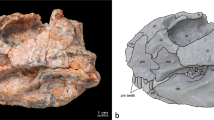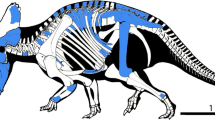Abstract
Ceratopsians (horned dinosaurs) represent one of the last and the most diverse radiations of non-avian dinosaurs1,2,3,4. Although recent systematic work unanimously supports a basal division of Ceratopsia into parrot-like psittacosaurids and frilled neoceratopsians, the early evolution of the group remains poorly understood, mainly owing to its incomplete early fossil record. Here we describe a primitive ceratopsian from China. Cladistic analysis posits this new species as the most basal neoceratopsian. This new taxon demonstrates that some neoceratopsian characters evolved in a more incremental fashion than previously known and also implies mosaic evolution of characters early in ceratopsian history.



Similar content being viewed by others
References
Dodson, P. & Currie, P. in The Dinosauria (eds Weishampel, D. B., Dodson, P. & Osmolska, H.) 593–618 (Univ. California Press, Berkeley, 1990).
Dodson, P. in Encyclopedia of Dinosaurs (eds Currie, P. J. & Padian, K.) 473–478 (Academic, San Diego, 1997).
Sereno, P. The origin and evolution of dinosaurs. Annu. Rev. Earth Planet. Sci. 25, 234–256 (1997).
Sereno, P. C. in The Age of Dinosaurs in Russia and Mongolia (eds Benton, M. J., Shishkin, M. A., Unwin, D. M. & Kurochkin, E. N.) 480–516 (Cambridge Univ. Press, New York, 2000).
Swisher, C. C. et al. Further support for a Cretaceous age for the feathered-dinosaur beds of Liaoning, China: new 40Ar/39Ar dating of the Yixian and Tuchengzi Formations. Chinese Sci. Bull. 46, 2009–2013 (2001).
Xu, X., Wang, X.-L. & You, H.-L. A primitive ornithopod form the Early Cretaceous Yixian Formation of Liaoning. Vertebrata PalAsiatica 38, 318–325 (2000).
Lo, C.-H., Chen, P.-J., Tsou, T.-Y., Sun, S.-S. & Lee, C. Y. 40Ar/39 laser single-grain and K–Ar dating of the Yixian Formation, NE China. Palaeoworld 11, 328–340 (1999).
Dong, Z.-M. & Azuma, Y. in Sino-Japanese Silk Road Dinosaur Expedition (ed. Dong, Z.-M.) 68–89 (China Ocean, Beijing, 1997).
Brown, B. & Schlaikjer, E. M. The structure and relationships of Protoceratops. Ann. NY Acad. Sci. 40, 133–266 (1940).
Sternberg, C. M. Complete skeleton of Leptoceratops gracilis Brown from the Upper Edmonton Member on Red Deer River, Alberta. Nat. Mus. Can. Bull. 123, 225–255 (1975).
Bohlin, B. Fossil Reptiles from Mongolia and Kansu (The Sino-Swedish Expedition, Statens Etnografiska Museum, Stockholm, 1953).
Zhao, X.-J., Cheng, Z.-W. & Xu, X. The earliest ceratopsian from the Tuchengzi Formation of Liaoning, China. J. Vert. Paleontol. 19, 681–691 (1999).
Maryanska, T. & Osmólska, H. Protoceratopsidae (Dinosauria) of Asia. Palaeontol. Polonica 33, 133–181 (1975).
Dodson, P. Quantitative aspects of relative growth and sexual dimorphism in Protoceratops. J. Paleontol. 50, 929–940 (1976).
Coombs, W. P. Juvenile specimens of the ornithischian dinosaur Psittacosaurus. Palaeontology 25, 89–107 (1982).
Sereno, P. C. in Dinosaur Systematics, Perspectives and Approaches (eds Carpenter, K. & Currie, P.) 203–210 (Cambridge Univ. Press, New York, 1990).
Chinnery, B. J. & Weishampel, D. B. Montanoceratops cerorhynchus (Dinosauria, Ceratopsia) and relationships among basal neoceratopsians. J. Vert. Paleontol. 18, 569–585 (1998).
Makovicky, P. J. in Mesozoic Terrestrial Life (eds Tanke, D. & Carpenter, K.) 243–262 (Univ. Indiana Press, Bloomington, 2001).
Acknowledgements
We thank Z.-H. Zhou for help during the course of the work, members of the Liaoxi expedition of the IVPP for help in the field, Y.-L. Huo, F.-L. Wang and H.-J. Wang for preparing the specimens, and R.-S. Li for drawings. This work was supported by the Special Funds for Major State Basic Research Projects of China, the National Geographic Society of USA, the Chinese Natural Science Foundation, the Chinese Academy of Sciences and The Field Museum.
Author information
Authors and Affiliations
Corresponding author
Ethics declarations
Competing interests
The authors declare no competing financial interests.
Supplementary information
Rights and permissions
About this article
Cite this article
Xu, X., Makovicky, P., Wang, Xl. et al. A ceratopsian dinosaur from China and the early evolution of Ceratopsia. Nature 416, 314–317 (2002). https://doi.org/10.1038/416314a
Received:
Accepted:
Issue Date:
DOI: https://doi.org/10.1038/416314a
- Springer Nature Limited
This article is cited by
-
A neoceratopsian dinosaur from the early Cretaceous of Mongolia and the early evolution of ceratopsia
Communications Biology (2020)
-
Study on the Jehol Biota: Recent advances and future prospects
Science China Earth Sciences (2020)
-
High-resolution computed tomographic analysis of tooth replacement pattern of the basal neoceratopsian Liaoceratops yanzigouensis informs ceratopsian dental evolution
Scientific Reports (2018)
-
A review of vertebrate body fossils from the Korean Peninsula and perspectives
Geosciences Journal (2017)
-
A psittacosaurid-like basal neoceratopsian from the Upper Cretaceous of central China and its implications for basal ceratopsian evolution
Scientific Reports (2015)





